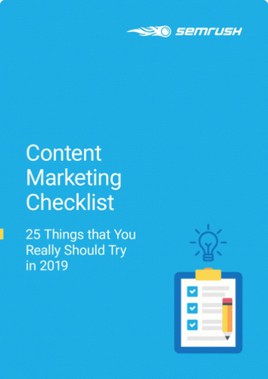Whether you’re about to start posting content on your website for the very first time or have been doing it for years, you should be constantly working on your blog’s content strategy.
Why?
Simple!
A blog content strategy allows you to get organised beforehand so you and your team know what kind of content is going to be published on your website in the next 4 to 6 weeks, allowing everybody to plan accordingly and meet their deadlines.
Now, there are many ways to plan a content strategy.
Each team develops its own way of creating content depending on their size, niche, budget, priorities and goals. However, they all have the ultimate goal of delivering high-quality content that converts, and it all starts with good research. Today, we’ll teach you how to create a content marketing strategy.
1. Decide what you want to write about

If you have been managing a blog for a while, then you probably know what kind of topics you would like to cover. However, if you are managing a new website, choosing the blog topics can be a challenge.
Either way, here are some tips that would help you get creative and organised:
Set a clear goal
You need to understand the reason why the blog posts are being written. In other words, your blog strategy should have a purpose. Ask yourself: “Why do I want people to read these blogs?”. You can tailor the blog strategy based on the answer. For instance, if the main goal of the blog posts is to promote your product, then the strategy is going to be different than if the goal was to simply make people spend more time on your site.
Know your audience
Have a clear idea of what kind of people you want to write for. Knowing the demographics is an excellent starting point, but the better you know your audience, the more likely you are to create content they will like.
Know your website
Depending on the size of your website, it is very important that your content stays consistent. Sometimes, even if some blog posts are about the same topic, they just don’t go well together. When planning a blog strategy, it is very important to step back and take a look at the big picture. In other words, you need to take a look at the content that is currently posted on the website and ask yourself if the new content would fit there. Having a well defined editorial line makes all the blog posts look great next to each other.
Once you know the audience, website and goals, you will have a broad idea of the topics you’d want to cover. This is the perfect moment to start brainstorming.
2. Brainstorm ideas and potential titles
Brainstorming blog posts ideas is fun because there are no rules, you can get as creative as you want. By yourself or with your team, write down every single idea that you think would make a good blog post. The more ideas you come up with the better. Feel free to include notes, quick drafts, examples from the web, and even potential titles. There are great tools to help you with this process. In fact, we wrote an entire article about the best tools to help you generate content marketing ideas, check it out and give them a try.
It is ok if your ideas look messy because the next step will be to clean up that list. Following a more technical process, you’ll get all the bad ideas out of the way.

3. Narrow Down Your Ideas: Elimination process and decision making
It is normal to get overly creative in a brainstorm session. That’s why it’s a good idea to take a break from work after a brainstorm session so you can better transition from the creative side of this process to the technical one. Go grab a snack or work on a different project. Once you clear your mind, come back to your list and go through everything you wrote. Just remember not to discard any idea just yet.
After going through everything once, feel free to start crossing out the topics that seem absolutely crazy or that don’t go with your vision and purpose as well as duplicates. Then, after this initial elimination process, you’ll have a nice list of potential topics to get started with the research. If you want to organise it further, you can create categories and cluster similar ideas together.
The way you clean the list will depend on the ultimate goal we discussed earlier in the article. If SEO is a big part of your content strategy, then keyword research is a great starting point. By focusing on search volume and keyword difficulty, you can discard the topics that won’t give you results.
Running a competitor analysis will also help you a lot. Who has already covered that topic? Can you create something better than them? If you know you cannot beat the competition, then you can move on to the next topic.
It is always a good idea to ask the rest of the team for their opinions. Asking them to vote for their favourite titles will give you a rough idea of popular topics.
Once you have a list of topics, don’t forget to consult with the legal department or any other person or department who would need to approve the topics. You need everyone to take a look at the titles before they become full articles, otherwise, you risk wasting valuable time if they decide not to publish an article that has already been produced.
4. Turn your ideas into an action plan
Once you have the topics you want to cover, it’s time to produce the content.
First, decide how often you want to blog. Then, determine how long your campaign is going to last. With these two aspects in mind, you can calculate the number of blog posts you will need and when you will need them ready by. Remember leaving enough room for writing, proofreading, rewriting, optimisation and final approval.
After that, you can set deadlines and start content production. More often than not, website owners choose niches they don’t know much about… and that’s fine! Just keep in mind that if you don’t know enough about a topic, hiring a writer is probably the best idea. It is worth the extra money. If your readers think you don’t know what you’re writing about, they simply won’t read your articles anymore… and no-one wants that.

Are you ready to plan the perfect content marketing strategy?
Remember, it all starts with deciding what to write about; knowing your audience and the content that’s been previously posted will help you decide what to write about. A brainstorming session can unleash your creativity; just write down all the ideas that come to your mind! After that, with the help of some tools and the rest of your team, clean up the list and discard ideas that won’t convert. Then, turn your ideas into an action plan! Decide who is going to work on what and set deadlines. Lastly, double check, optimise and publish your content.
The key to planning the perfect content marketing strategy is to stay organised. If done correctly, content marketing can boost your blog and bring you new business opportunities.
Hopefully the tips in this article help you get started with planning yo ur blog content strategy. If you want to know more about how Taksu approaches content marketing, or need some direction and support to help improve your content strategy, feel free to check our content marketing services or reach out to our team via contact@taksudigital.com
For further reading check out SEM Rush’s Content Marketing Checklist – 25 Things that You Really Should Try in 2020









